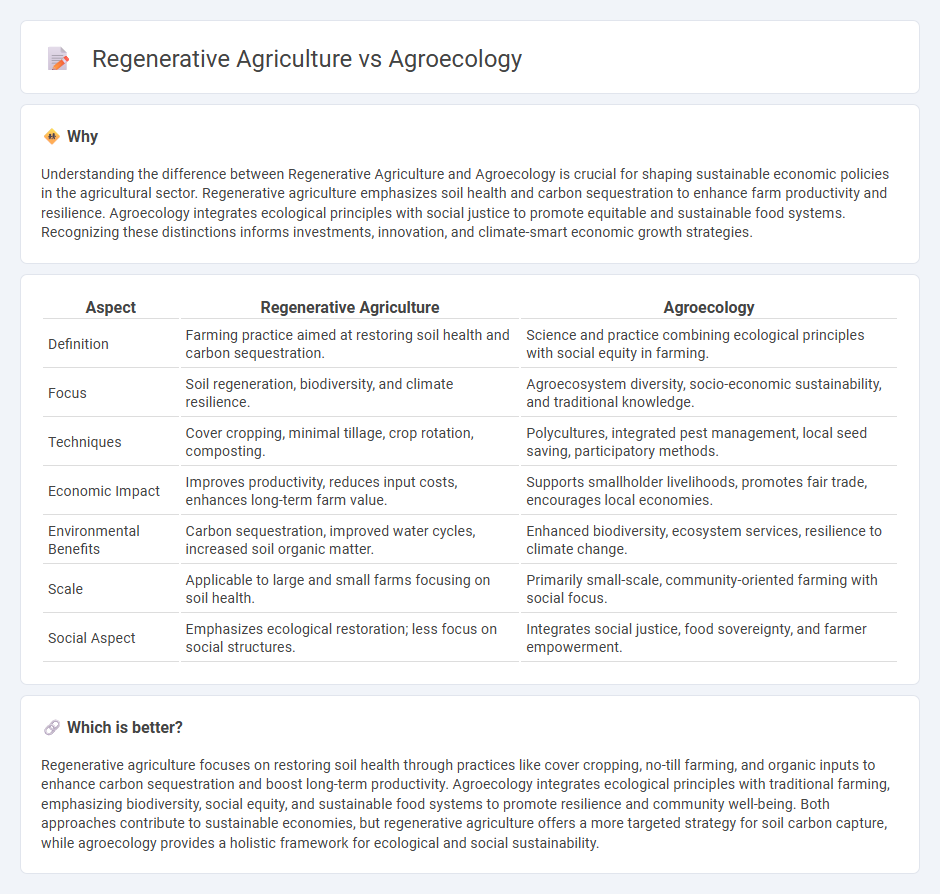
Regenerative agriculture focuses on restoring soil health, increasing biodiversity, and enhancing ecosystem services to create sustainable farming systems that sequester carbon and improve long-term productivity. Agroecology integrates ecological principles into agricultural practices, emphasizing social equity, local knowledge, and biodiversity to foster resilient and diversified food systems. Explore how these innovative approaches transform the economy and promote sustainable development.
Why it is important
Understanding the difference between Regenerative Agriculture and Agroecology is crucial for shaping sustainable economic policies in the agricultural sector. Regenerative agriculture emphasizes soil health and carbon sequestration to enhance farm productivity and resilience. Agroecology integrates ecological principles with social justice to promote equitable and sustainable food systems. Recognizing these distinctions informs investments, innovation, and climate-smart economic growth strategies.
Comparison Table
| Aspect | Regenerative Agriculture | Agroecology |
|---|---|---|
| Definition | Farming practice aimed at restoring soil health and carbon sequestration. | Science and practice combining ecological principles with social equity in farming. |
| Focus | Soil regeneration, biodiversity, and climate resilience. | Agroecosystem diversity, socio-economic sustainability, and traditional knowledge. |
| Techniques | Cover cropping, minimal tillage, crop rotation, composting. | Polycultures, integrated pest management, local seed saving, participatory methods. |
| Economic Impact | Improves productivity, reduces input costs, enhances long-term farm value. | Supports smallholder livelihoods, promotes fair trade, encourages local economies. |
| Environmental Benefits | Carbon sequestration, improved water cycles, increased soil organic matter. | Enhanced biodiversity, ecosystem services, resilience to climate change. |
| Scale | Applicable to large and small farms focusing on soil health. | Primarily small-scale, community-oriented farming with social focus. |
| Social Aspect | Emphasizes ecological restoration; less focus on social structures. | Integrates social justice, food sovereignty, and farmer empowerment. |
Which is better?
Regenerative agriculture focuses on restoring soil health through practices like cover cropping, no-till farming, and organic inputs to enhance carbon sequestration and boost long-term productivity. Agroecology integrates ecological principles with traditional farming, emphasizing biodiversity, social equity, and sustainable food systems to promote resilience and community well-being. Both approaches contribute to sustainable economies, but regenerative agriculture offers a more targeted strategy for soil carbon capture, while agroecology provides a holistic framework for ecological and social sustainability.
Connection
Regenerative agriculture and agroecology both emphasize sustainable farming practices that restore soil health, enhance biodiversity, and increase ecosystem resilience, critical for boosting long-term agricultural productivity and economic sustainability. These approaches reduce dependency on synthetic inputs, lowering production costs and supporting local economies through improved resource efficiency and climate resilience. Integrating regenerative agriculture with agroecological principles fosters circular economies within rural communities, promoting food security and economic stability.
Key Terms
Sustainable Production
Agroecology integrates ecological principles with agricultural practices to enhance biodiversity, soil health, and resource efficiency, fostering sustainable food systems. Regenerative agriculture emphasizes restoring degraded soils, increasing carbon sequestration, and improving ecosystem resilience through techniques like cover cropping and reduced tillage. Explore how these approaches contribute uniquely to sustainable production and global food security.
Market Systems
Agroecology emphasizes diverse, resilient farming systems that integrate ecological principles to enhance biodiversity and local food sovereignty within market systems. Regenerative agriculture focuses on restoring soil health and ecosystem functions through practices like cover cropping and holistic grazing to create sustainable market opportunities. Explore how these approaches transform food supply chains and drive market innovations.
Value Chains
Agroecology emphasizes sustainable farming practices that enhance biodiversity and ecosystem health within agricultural value chains, promoting local food systems and empowering small-scale farmers. Regenerative agriculture focuses on restoring soil health and capturing carbon, creating resilient value chains through practices like cover cropping, no-till farming, and holistic grazing. Explore how integrating these approaches can revolutionize value chain sustainability and economic viability.
Source and External Links
What is Agroecology? - Agroecology is an integrated approach combining ecological and social principles in designing and managing food and agricultural systems to promote sustainability, equity, and resilience, emphasizing the rights of women, youth, and Indigenous Peoples and empowering local communities through knowledge co-creation.
Overview | Agroecology Knowledge Hub - Agroecology is a holistic, transdisciplinary approach to sustainable agriculture and food systems that integrates ecological and social concepts to optimize interactions among plants, animals, humans, and the environment while enhancing food security, local development, and resilience.
Agroecology - Wikipedia - Agroecology is an academic discipline and holistic approach that applies ecological principles to agricultural systems, studying interactions within ecosystems and incorporating social sciences to address productivity, sustainability, and equity in farming and food systems.
 dowidth.com
dowidth.com